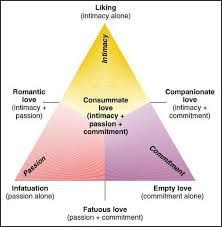How the Triangular Theory of Love Can Lead to Fulfilling Intimate Connections and Relationships7/23/2021 Author: Alejandra Hilbert  Psychologist Robert Sternberg proposed that there are three different building blocks which combine to form different types of love. These components are intimacy, passion, and commitment. Intimacy is defined as feelings of warmth, understanding, trust, support, and sharing. Passion is characterized by physical arousal and desire, excitement, and need. Finally, commitment is typified by feelings of permanence, stability, and the decisions to devote oneself to a relationship and to work to maintain it. Under Sternberg’s model, there are eight relationship types (as illustrated here). Utilizing Sternberg’s conceptualization of romantic partnerships, one can compare a romantic relationship to a stool. A stool only propped up by one leg is much less likely to support one’s weight, whereas a three legged stool could unwaveringly; thus, relationships with two or more of the critical components will lead to a greater sense of fulfillment, dependence, and security. Utilizing the stool metaphor, single leg relationships are those with only one building block. An example of this relationship structure is empty love, which describes a relationship where commitment is high, but there is little intimacy or passion—in essence, a work relationship. Conversely, a relationship which is high in passion but lacks intimacy and commitment is infatuation, or colloquially known as a crush. Intimacy, passion, and commitment are all absent in nonlove. Ideally, a strong dose of all three components should exist within the partnership, as typified by consummate love. Throughout the course of the relationship, there will likely be a shift in prevalence of particular blocks and how they appear. Passion may run high in the beginning of a new romantic relationship, as coined by the term new relationship energy (NRE). Sheer novelty adds excitement and energy to new loves. Once a relationship is established and novelty is lost, passion slowly subsides; typically the longer a relationship lasts, the less passionate it becomes. However, other components, like intimacy and commitment, are bolstered to maintain balance. Time alone does not cause intimacy, passion, and commitment to occur and grow, but rather deliberate effort is needed to foster these critical components if they do not initially exist in your partnership. Knowledge of this model of love may help couples avoid pitfalls in their relationship, allow for intentional work in areas that need improvement, or aid partnerships recognize when it may be time for a relationship to end. Sternberg asserts that reaching consummate love is often easier than maintaining it. Understanding that there is an ebb and flow in which building blocks may appear in our relationships, have are few recommendations on how to cultivate continuous consummate love:
Sources
0 Comments
Author: Cate Cabri Connections with others have a major impact on our happiness as well as our well-being. One way that many people seek to strengthen these connections with others is through the use of social media. Social media has become so commonly used in our society as a main method of communication for many people, sometimes even replacing face-to-face interactions. Although there are some positive aspects of using social media, there are also major concerns, including raising levels of anxiety and depression. If used in an unhealthy way, social media can take a major toll on people's mental health. A few warning signs to look out for that social media could be negatively affecting your mental health include:
However, if used in a healthy way, there are many positive aspects of social media.
Research on the impacts of social media on anxiety has shown that anxious people tend to rely on social media as a means of escaping from what they are worried about. However, once on social media, new stressors become an issue that fuels the initial anxiety that the person was already experiencing. Individuals with Generalized Anxiety Disorder, for example, often compare themselves negatively with others on social media, which leads to a higher level of anxiety than they were initially experiencing. Social media can be an addictive platform. Research has shown that posting a photo and getting lots of likes and positive, validating comments can be addictive. When you receive positive feedback on a post, this triggers the release of dopamine in the brain (a “reward” chemical). This can cause people to want to continue posting to get more of this validation. This is something to keep in mind when using social media - what is your intention and why are you choosing to post? There is not necessarily one correct intention with posting on social media but it is something to consider, as using social media for the wrong reasons (like for the purpose of only using it to try to get validation or trying to fit in with others) can lead to an unhealthy relationship with social media and can contribute to feelings of anxiety and depression. Overall, there are positive aspects to social media when used in a healthy way, and it is important to consider your own social media use and how it is affecting your life. Check in with yourself on your social media use and consider any adjustments that you could make to ensure that social media is affecting your life in a positive way. Sources: Social Media and Mental Health The Impact of Social Media on Youth Mental Health Anxiety and Social Media Use Does Social Media Cause Depression?  About the author: Cate is a student at Loyola University Chicago where she is majoring in Psychology with a minor in Psychology of Crime and Justice. She plans on attending graduate school to become a clinical social worker. In her free time, she enjoys hiking and spending time with family and friends. |
Archives
October 2021
Categories |
- Home
- For Clients
-
For Professionals
- All Trainings
- On Demand Workshops
- Attachment Based - CBST Yearlong
- Summer Intensive
- One Way Mirror Training
- Consultation Groups
- CBT Training
- EFT Couples Training
- Family Therapy Training
- ESSFT Certification
- EMDR Training
- Child Therapy
- Motivational Interviewing
- ADHD Treatment
- Seeing the Blind Spots: A Consultation Group for Examining White Therapists' Privilege
- Seeing the Blind Spots: Exploring How You Think About and Experience Gender Diversity
- Supervision, Law, and Ethics
- Telehealth Workshop
- DBT for Alcohol and Drug Addiction
- Strength Based Culturally Informed Integrative Therapy
- About
- Contact




 RSS Feed
RSS Feed